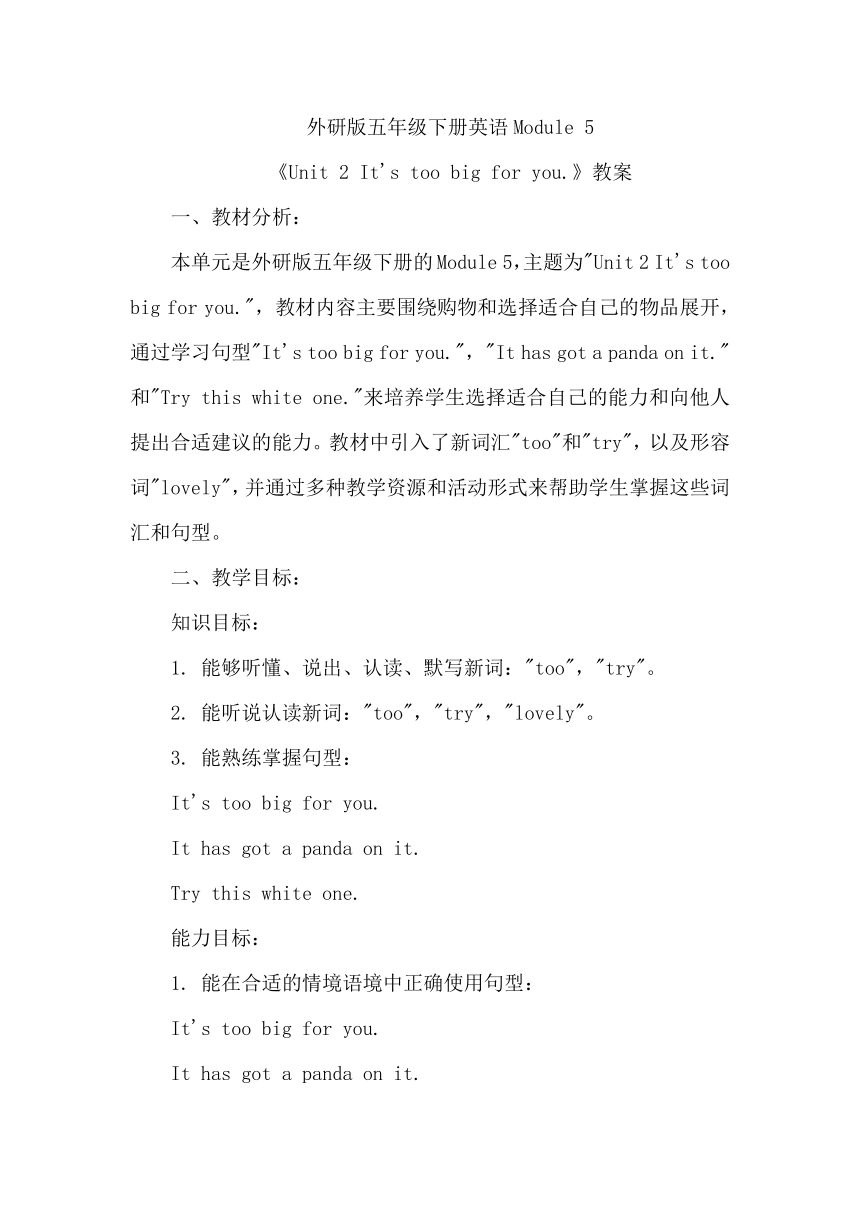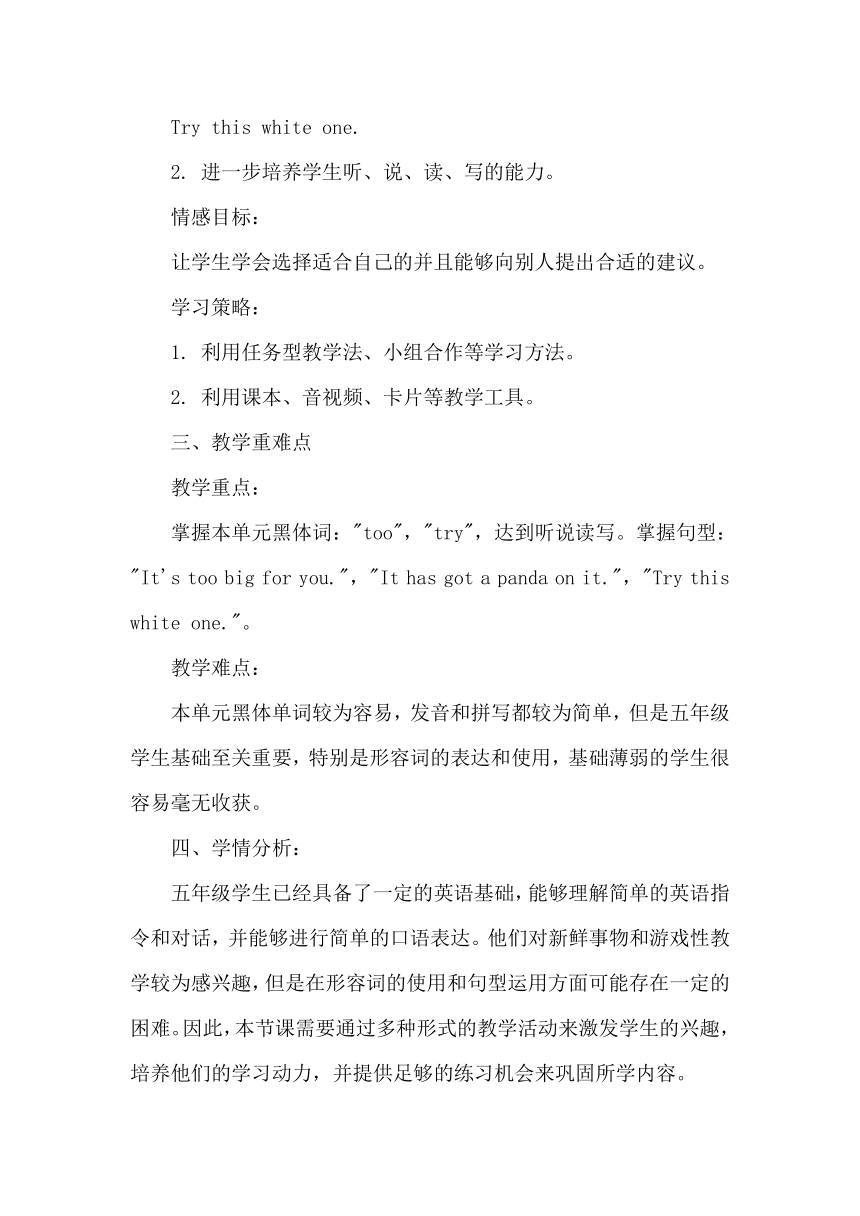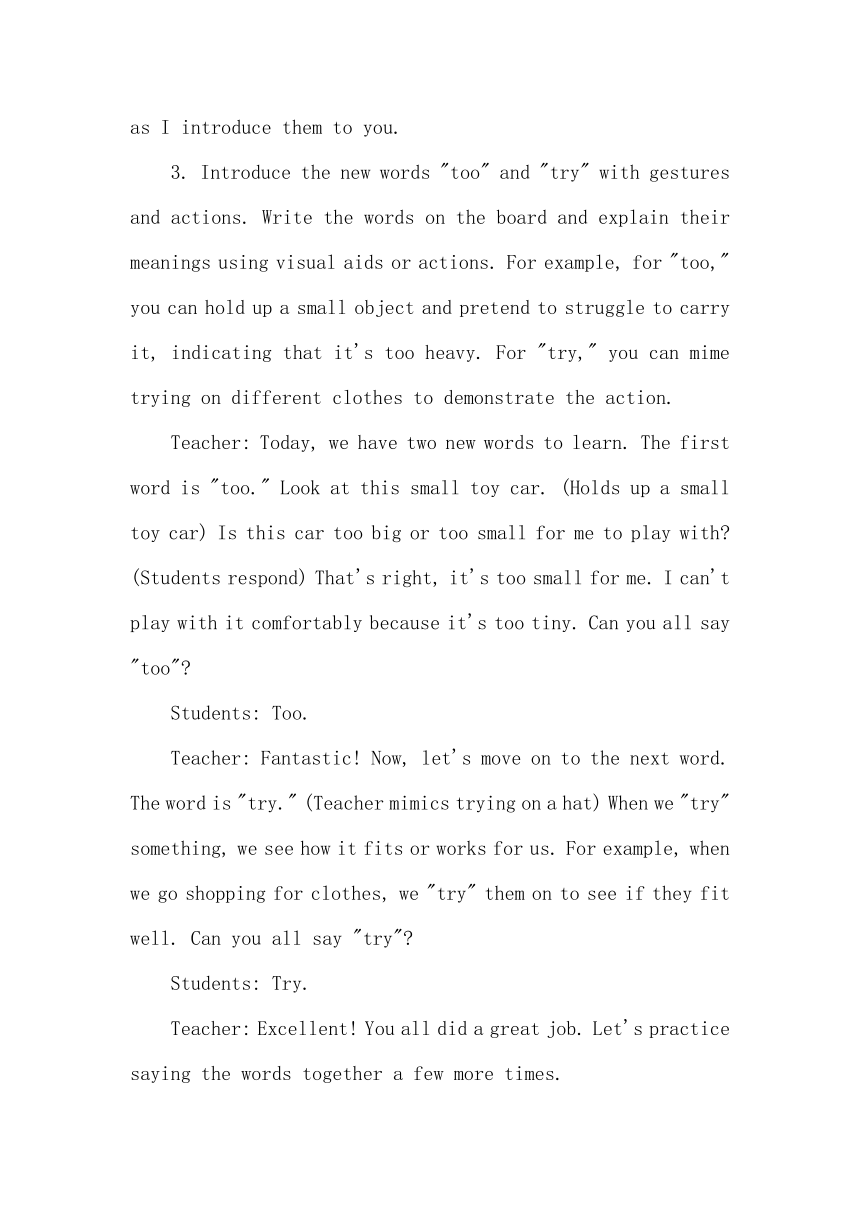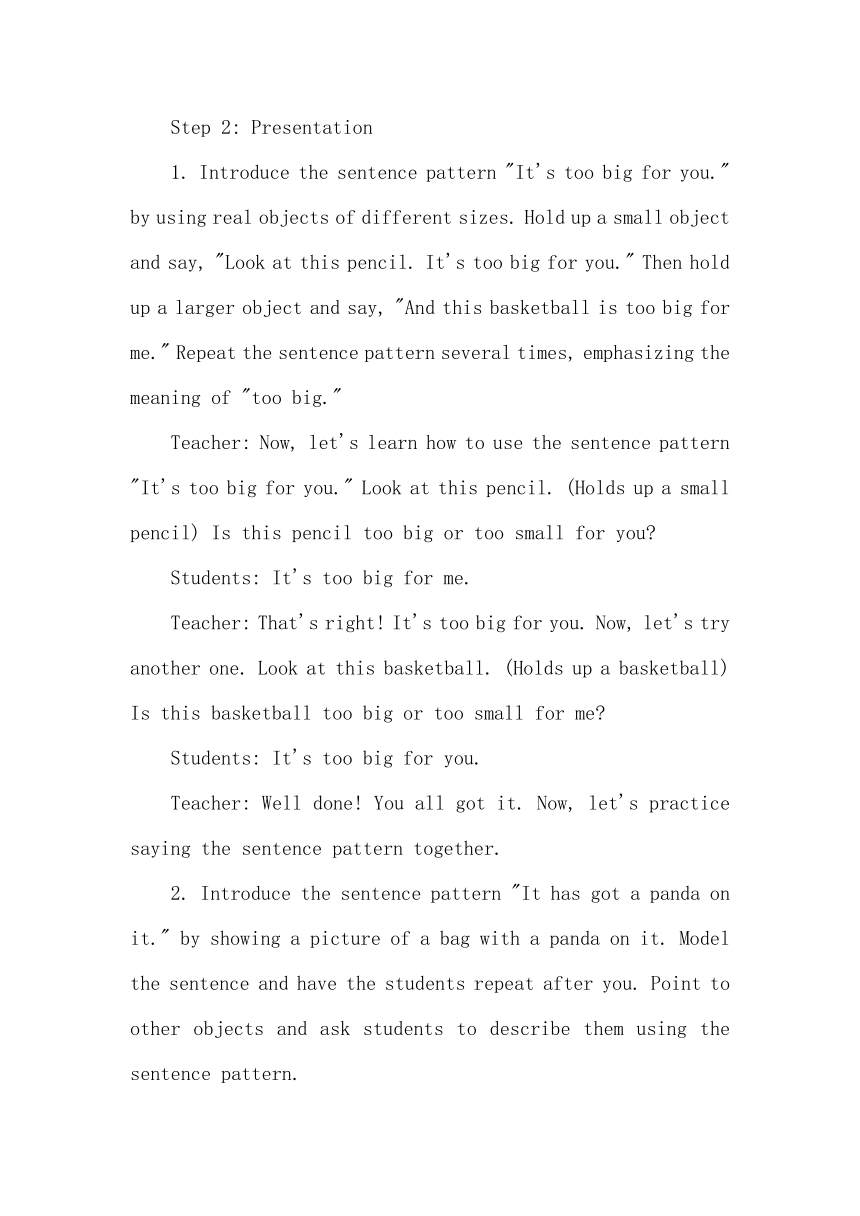Module 5 Unit 2 It's too big for you.教案(含教学反思)
文档属性
| 名称 | Module 5 Unit 2 It's too big for you.教案(含教学反思) |

|
|
| 格式 | docx | ||
| 文件大小 | 17.2KB | ||
| 资源类型 | 教案 | ||
| 版本资源 | 外研版(三年级起点) | ||
| 科目 | 英语 | ||
| 更新时间 | 2024-03-25 10:45:59 | ||
图片预览





文档简介
外研版五年级下册英语Module 5
《Unit 2 It's too big for you.》教案
一、教材分析:
本单元是外研版五年级下册的Module 5,主题为"Unit 2 It's too big for you.",教材内容主要围绕购物和选择适合自己的物品展开,通过学习句型"It's too big for you.","It has got a panda on it."和"Try this white one."来培养学生选择适合自己的能力和向他人提出合适建议的能力。教材中引入了新词汇"too"和"try",以及形容词"lovely",并通过多种教学资源和活动形式来帮助学生掌握这些词汇和句型。
二、教学目标:
知识目标:
1. 能够听懂、说出、认读、默写新词:"too","try"。
2. 能听说认读新词:"too","try","lovely"。
3. 能熟练掌握句型:
It's too big for you.
It has got a panda on it.
Try this white one.
能力目标:
1. 能在合适的情境语境中正确使用句型:
It's too big for you.
It has got a panda on it.
Try this white one.
2. 进一步培养学生听、说、读、写的能力。
情感目标:
让学生学会选择适合自己的并且能够向别人提出合适的建议。
学习策略:
1. 利用任务型教学法、小组合作等学习方法。
2. 利用课本、音视频、卡片等教学工具。
三、教学重难点
教学重点:
掌握本单元黑体词:"too","try",达到听说读写。掌握句型:"It's too big for you.","It has got a panda on it.","Try this white one."。
教学难点:
本单元黑体单词较为容易,发音和拼写都较为简单,但是五年级学生基础至关重要,特别是形容词的表达和使用,基础薄弱的学生很容易毫无收获。
四、学情分析:
五年级学生已经具备了一定的英语基础,能够理解简单的英语指令和对话,并能够进行简单的口语表达。他们对新鲜事物和游戏性教学较为感兴趣,但是在形容词的使用和句型运用方面可能存在一定的困难。因此,本节课需要通过多种形式的教学活动来激发学生的兴趣,培养他们的学习动力,并提供足够的练习机会来巩固所学内容。
教学过程
Step 1: Warm-up
1. Greet the students and briefly review the previous lesson by asking questions related to the topic. For example, you can ask, "Do you remember what we learned in the last lesson about shopping and choosing things "
2. Show pictures of different objects on the board or using flashcards. Point to each picture and elicit the names of the objects from the students. Encourage them to use complete sentences when responding. For example, if you show a picture of a shirt, ask, "What is this " and expect the students to respond with "It's a shirt."
Teacher: Good morning, everyone! How are you today Let's quickly review what we learned in our last lesson. Who can tell me something we talked about when we went shopping
Student 1: We learned about choosing things that are the right size.
Teacher: Great! That's correct. Now, let's look at some pictures. What is this (Pointing to a picture of a shirt)
Student 2: It's a shirt.
Teacher: Excellent! Well done, everyone. Now, let's move on to some new words we will learn today. Please pay attention as I introduce them to you.
3. Introduce the new words "too" and "try" with gestures and actions. Write the words on the board and explain their meanings using visual aids or actions. For example, for "too," you can hold up a small object and pretend to struggle to carry it, indicating that it's too heavy. For "try," you can mime trying on different clothes to demonstrate the action.
Teacher: Today, we have two new words to learn. The first word is "too." Look at this small toy car. (Holds up a small toy car) Is this car too big or too small for me to play with (Students respond) That's right, it's too small for me. I can't play with it comfortably because it's too tiny. Can you all say "too"
Students: Too.
Teacher: Fantastic! Now, let's move on to the next word. The word is "try." (Teacher mimics trying on a hat) When we "try" something, we see how it fits or works for us. For example, when we go shopping for clothes, we "try" them on to see if they fit well. Can you all say "try"
Students: Try.
Teacher: Excellent! You all did a great job. Let's practice saying the words together a few more times.
Step 2: Presentation
1. Introduce the sentence pattern "It's too big for you." by using real objects of different sizes. Hold up a small object and say, "Look at this pencil. It's too big for you." Then hold up a larger object and say, "And this basketball is too big for me." Repeat the sentence pattern several times, emphasizing the meaning of "too big."
Teacher: Now, let's learn how to use the sentence pattern "It's too big for you." Look at this pencil. (Holds up a small pencil) Is this pencil too big or too small for you
Students: It's too big for me.
Teacher: That's right! It's too big for you. Now, let's try another one. Look at this basketball. (Holds up a basketball) Is this basketball too big or too small for me
Students: It's too big for you.
Teacher: Well done! You all got it. Now, let's practice saying the sentence pattern together.
2. Introduce the sentence pattern "It has got a panda on it." by showing a picture of a bag with a panda on it. Model the sentence and have the students repeat after you. Point to other objects and ask students to describe them using the sentence pattern.
Teacher: Now, let's learn another sentence pattern. Look at this bag. (Shows a picture of a bag with a panda on it) What do you see on this bag
Students: It has got a panda on it.
Teacher: Excellent! You all have great observation skills. Now, let's try it with some other objects. (Points to different objects) What does this pencil case have on it
Students: It has got...
[Continue presenting other objects and practicing the sentence pattern.]
3. Introduce the sentence pattern "Try this white one." by showing two objects of different colors. Model the sentence and have the students repeat after you. Ask students to make their own sentences using different colors and objects.
Teacher: We have one more sentence pattern to learn today. Look at these two shirts. (Shows two shirts, one white and one blue) Which shirt should I try on
Students: Try the white one.
Teacher: Yes, exactly! Try this white one. Now, I want you to work with your partner and create your own sentences using different colors and objects. For example, you can say, "Try the green one" or "Try the red one."
[Encourage students to practice the sentence pattern with different colors and objects.]
Step 3: Practice
1. Divide the class into pairs or small groups. Give each group a set of flashcards with different objects and colors.
Teacher: Now, it's time to practice what we've learned in pairs or small groups. I will give each group a set of flashcards with different objects and colors. Take turns using the sentence patterns we learned to describe the flashcards and make suggestions to your partners. Remember to use "too" and "try" appropriately.
2. Have the students take turns using the sentence patterns to describe the flashcards and make suggestions to their partners. Encourage them to use complete sentences and practice their pronunciation.
Student A: (Holding a flashcard with a blue shirt) This blue shirt is too big for you. Try the red one instead.
Student B: (Holding a flashcard with a red shirt) Okay, I'll try the red one. Thank you!
[Encourage students to engage in conversations using the sentence patterns.]
3. Walk around the classroom, monitor the students' conversations, and provide assistance when needed. Offer feedback and correct any errors in pronunciation or sentence structure.
Teacher: (Listening to a group's conversation) Great job, everyone! I like how you're using the sentence patterns correctly. Just remember to pronounce "too" and "try" clearly. Keep up the good work!
4. After the practice activity, gather the students together and ask some pairs or groups to share their interesting descriptions and suggestions with the whole class.
Teacher: It's wonderful to see all the conversations happening in the classroom. Now, let's hear from some of the pairs or groups. Who would like to share an interesting description or suggestion they made
Student 1: We had a discussion about these shoes. I said, "These shoes are too big for you. Try the black ones instead."
Student 2: And I tried the black ones, and they fit perfectly! I'm glad I listened to the suggestion.
Teacher: That's fantastic! It's important to help each other and make suggestions based on what we observe. Well done, both of you!
Step 4: Consolidation
1. Play a game called "Guess the Object." Prepare a bag with different objects inside.
Teacher: Now, it's time for a fun game called "Guess the Object." I have a bag with different objects inside. I will take out one object at a time, but I won't show it to you. I will describe the object using the sentence patterns we learned today, and you have to guess what it is. Are you ready
Students: Yes!
2. Take out one object at a time without showing it to the students. Describe the object using the sentence patterns and have the students guess what it is. Encourage the students to use the sentence patterns and vocabulary they have learned to describe and guess the objects.
Teacher: (Taking out an object from the bag) This object is too heavy to carry. What do you think it is
Student 1: Is it a dumbbell
Teacher: Yes, it is! Well done!
[Continue the game with different objects and sentence patterns.]
Step 5: Wrap-up
1. Review the new words and sentence patterns together with the students.
Teacher: Before we finish, let's quickly review the new words and sentence patterns we learned today. Can anyone remind me of one of the new words we learned
Student 1: "Too" and "try"!
Teacher: That's correct! We learned the words "too" and "try." And what was one of the sentence patterns we practiced
Student 2: "It's too big for you."
Teacher: Great job! We practiced the sentence pattern "It's too big for you." Excellent work, everyone!
2. Ask the students to summarize what they have learned in this lesson.
Teacher: Now, I would like each of you to take a moment and think about what you have learned in today's lesson. When I call your name, please share one thing you remember.
[Call on students one by one to share their summaries.]
3. Assign homework, such as practicing the sentence patterns with family members or friends.
Teacher: Your homework for tonight is to practice using the sentence patterns we learned today. You can do this by describing objects at home or making suggestions to your family members or friends. Have fun with it!
Students: Okay, teacher!
Teacher: Well done, everyone! That brings us to the end of today's lesson. I hope you enjoyed it and learned a lot. See you next time!
六、板书设计:
New Words:too,try,lovely
Sentence Patterns:
It's too big for you.
It has got a panda on it.
Try this white one.
七、教学反思:
本节课通过任务型教学法和小组合作等多种教学方法,使学生在实践中掌握了新词汇和句型。通过图片、实物和游戏等多种教具的运用,激发了学生的学习兴趣,提高了他们的参与度。但是在实际教学过程中,发现部分学生对形容词的使用还存在一定的困难,需要进一步巩固和练习。因此,在以后的教学中,可以增加更多的练习环节,例如填空、对话练习等,帮助学生更好地掌握形容词的用法。此外,及时给予学生肯定和鼓励,激发他们的学习动力,促进语言能力的提高。
《Unit 2 It's too big for you.》教案
一、教材分析:
本单元是外研版五年级下册的Module 5,主题为"Unit 2 It's too big for you.",教材内容主要围绕购物和选择适合自己的物品展开,通过学习句型"It's too big for you.","It has got a panda on it."和"Try this white one."来培养学生选择适合自己的能力和向他人提出合适建议的能力。教材中引入了新词汇"too"和"try",以及形容词"lovely",并通过多种教学资源和活动形式来帮助学生掌握这些词汇和句型。
二、教学目标:
知识目标:
1. 能够听懂、说出、认读、默写新词:"too","try"。
2. 能听说认读新词:"too","try","lovely"。
3. 能熟练掌握句型:
It's too big for you.
It has got a panda on it.
Try this white one.
能力目标:
1. 能在合适的情境语境中正确使用句型:
It's too big for you.
It has got a panda on it.
Try this white one.
2. 进一步培养学生听、说、读、写的能力。
情感目标:
让学生学会选择适合自己的并且能够向别人提出合适的建议。
学习策略:
1. 利用任务型教学法、小组合作等学习方法。
2. 利用课本、音视频、卡片等教学工具。
三、教学重难点
教学重点:
掌握本单元黑体词:"too","try",达到听说读写。掌握句型:"It's too big for you.","It has got a panda on it.","Try this white one."。
教学难点:
本单元黑体单词较为容易,发音和拼写都较为简单,但是五年级学生基础至关重要,特别是形容词的表达和使用,基础薄弱的学生很容易毫无收获。
四、学情分析:
五年级学生已经具备了一定的英语基础,能够理解简单的英语指令和对话,并能够进行简单的口语表达。他们对新鲜事物和游戏性教学较为感兴趣,但是在形容词的使用和句型运用方面可能存在一定的困难。因此,本节课需要通过多种形式的教学活动来激发学生的兴趣,培养他们的学习动力,并提供足够的练习机会来巩固所学内容。
教学过程
Step 1: Warm-up
1. Greet the students and briefly review the previous lesson by asking questions related to the topic. For example, you can ask, "Do you remember what we learned in the last lesson about shopping and choosing things "
2. Show pictures of different objects on the board or using flashcards. Point to each picture and elicit the names of the objects from the students. Encourage them to use complete sentences when responding. For example, if you show a picture of a shirt, ask, "What is this " and expect the students to respond with "It's a shirt."
Teacher: Good morning, everyone! How are you today Let's quickly review what we learned in our last lesson. Who can tell me something we talked about when we went shopping
Student 1: We learned about choosing things that are the right size.
Teacher: Great! That's correct. Now, let's look at some pictures. What is this (Pointing to a picture of a shirt)
Student 2: It's a shirt.
Teacher: Excellent! Well done, everyone. Now, let's move on to some new words we will learn today. Please pay attention as I introduce them to you.
3. Introduce the new words "too" and "try" with gestures and actions. Write the words on the board and explain their meanings using visual aids or actions. For example, for "too," you can hold up a small object and pretend to struggle to carry it, indicating that it's too heavy. For "try," you can mime trying on different clothes to demonstrate the action.
Teacher: Today, we have two new words to learn. The first word is "too." Look at this small toy car. (Holds up a small toy car) Is this car too big or too small for me to play with (Students respond) That's right, it's too small for me. I can't play with it comfortably because it's too tiny. Can you all say "too"
Students: Too.
Teacher: Fantastic! Now, let's move on to the next word. The word is "try." (Teacher mimics trying on a hat) When we "try" something, we see how it fits or works for us. For example, when we go shopping for clothes, we "try" them on to see if they fit well. Can you all say "try"
Students: Try.
Teacher: Excellent! You all did a great job. Let's practice saying the words together a few more times.
Step 2: Presentation
1. Introduce the sentence pattern "It's too big for you." by using real objects of different sizes. Hold up a small object and say, "Look at this pencil. It's too big for you." Then hold up a larger object and say, "And this basketball is too big for me." Repeat the sentence pattern several times, emphasizing the meaning of "too big."
Teacher: Now, let's learn how to use the sentence pattern "It's too big for you." Look at this pencil. (Holds up a small pencil) Is this pencil too big or too small for you
Students: It's too big for me.
Teacher: That's right! It's too big for you. Now, let's try another one. Look at this basketball. (Holds up a basketball) Is this basketball too big or too small for me
Students: It's too big for you.
Teacher: Well done! You all got it. Now, let's practice saying the sentence pattern together.
2. Introduce the sentence pattern "It has got a panda on it." by showing a picture of a bag with a panda on it. Model the sentence and have the students repeat after you. Point to other objects and ask students to describe them using the sentence pattern.
Teacher: Now, let's learn another sentence pattern. Look at this bag. (Shows a picture of a bag with a panda on it) What do you see on this bag
Students: It has got a panda on it.
Teacher: Excellent! You all have great observation skills. Now, let's try it with some other objects. (Points to different objects) What does this pencil case have on it
Students: It has got...
[Continue presenting other objects and practicing the sentence pattern.]
3. Introduce the sentence pattern "Try this white one." by showing two objects of different colors. Model the sentence and have the students repeat after you. Ask students to make their own sentences using different colors and objects.
Teacher: We have one more sentence pattern to learn today. Look at these two shirts. (Shows two shirts, one white and one blue) Which shirt should I try on
Students: Try the white one.
Teacher: Yes, exactly! Try this white one. Now, I want you to work with your partner and create your own sentences using different colors and objects. For example, you can say, "Try the green one" or "Try the red one."
[Encourage students to practice the sentence pattern with different colors and objects.]
Step 3: Practice
1. Divide the class into pairs or small groups. Give each group a set of flashcards with different objects and colors.
Teacher: Now, it's time to practice what we've learned in pairs or small groups. I will give each group a set of flashcards with different objects and colors. Take turns using the sentence patterns we learned to describe the flashcards and make suggestions to your partners. Remember to use "too" and "try" appropriately.
2. Have the students take turns using the sentence patterns to describe the flashcards and make suggestions to their partners. Encourage them to use complete sentences and practice their pronunciation.
Student A: (Holding a flashcard with a blue shirt) This blue shirt is too big for you. Try the red one instead.
Student B: (Holding a flashcard with a red shirt) Okay, I'll try the red one. Thank you!
[Encourage students to engage in conversations using the sentence patterns.]
3. Walk around the classroom, monitor the students' conversations, and provide assistance when needed. Offer feedback and correct any errors in pronunciation or sentence structure.
Teacher: (Listening to a group's conversation) Great job, everyone! I like how you're using the sentence patterns correctly. Just remember to pronounce "too" and "try" clearly. Keep up the good work!
4. After the practice activity, gather the students together and ask some pairs or groups to share their interesting descriptions and suggestions with the whole class.
Teacher: It's wonderful to see all the conversations happening in the classroom. Now, let's hear from some of the pairs or groups. Who would like to share an interesting description or suggestion they made
Student 1: We had a discussion about these shoes. I said, "These shoes are too big for you. Try the black ones instead."
Student 2: And I tried the black ones, and they fit perfectly! I'm glad I listened to the suggestion.
Teacher: That's fantastic! It's important to help each other and make suggestions based on what we observe. Well done, both of you!
Step 4: Consolidation
1. Play a game called "Guess the Object." Prepare a bag with different objects inside.
Teacher: Now, it's time for a fun game called "Guess the Object." I have a bag with different objects inside. I will take out one object at a time, but I won't show it to you. I will describe the object using the sentence patterns we learned today, and you have to guess what it is. Are you ready
Students: Yes!
2. Take out one object at a time without showing it to the students. Describe the object using the sentence patterns and have the students guess what it is. Encourage the students to use the sentence patterns and vocabulary they have learned to describe and guess the objects.
Teacher: (Taking out an object from the bag) This object is too heavy to carry. What do you think it is
Student 1: Is it a dumbbell
Teacher: Yes, it is! Well done!
[Continue the game with different objects and sentence patterns.]
Step 5: Wrap-up
1. Review the new words and sentence patterns together with the students.
Teacher: Before we finish, let's quickly review the new words and sentence patterns we learned today. Can anyone remind me of one of the new words we learned
Student 1: "Too" and "try"!
Teacher: That's correct! We learned the words "too" and "try." And what was one of the sentence patterns we practiced
Student 2: "It's too big for you."
Teacher: Great job! We practiced the sentence pattern "It's too big for you." Excellent work, everyone!
2. Ask the students to summarize what they have learned in this lesson.
Teacher: Now, I would like each of you to take a moment and think about what you have learned in today's lesson. When I call your name, please share one thing you remember.
[Call on students one by one to share their summaries.]
3. Assign homework, such as practicing the sentence patterns with family members or friends.
Teacher: Your homework for tonight is to practice using the sentence patterns we learned today. You can do this by describing objects at home or making suggestions to your family members or friends. Have fun with it!
Students: Okay, teacher!
Teacher: Well done, everyone! That brings us to the end of today's lesson. I hope you enjoyed it and learned a lot. See you next time!
六、板书设计:
New Words:too,try,lovely
Sentence Patterns:
It's too big for you.
It has got a panda on it.
Try this white one.
七、教学反思:
本节课通过任务型教学法和小组合作等多种教学方法,使学生在实践中掌握了新词汇和句型。通过图片、实物和游戏等多种教具的运用,激发了学生的学习兴趣,提高了他们的参与度。但是在实际教学过程中,发现部分学生对形容词的使用还存在一定的困难,需要进一步巩固和练习。因此,在以后的教学中,可以增加更多的练习环节,例如填空、对话练习等,帮助学生更好地掌握形容词的用法。此外,及时给予学生肯定和鼓励,激发他们的学习动力,促进语言能力的提高。
同课章节目录
- Module 1
- Unit 1 We lived in a small house.
- Unit 2 She didn't have a television.
- Module 2
- Unit 1 She learnt English.
- Unit 2 Mr Li was a teacher.
- Module 3
- Unit 1 She had eggs and sausages.
- Unit 2 Sam ate four hamburgers.
- Module 4
- Unit 1 Let's make a home library.
- Unit 2 We can find information from books and CDs.
- Module 5
- Unit 1 It's big and light.
- Unit 2 It's too big for you.
- Module 6
- Unit 1 I went there last year.
- Unit 2 She visited the Tianchi Lake.
- Module 7
- Unit 1 My father goes to work at eight o'clock eve
- Unit 2 I'll be home at seven o'clock.
- Module 8
- Unit 1 Will you help me?
- Unit 2 I made a kite.
- Module 9
- Unit 1 We laughed a lot.
- Unit 2 Mum bought new T-shirts for you.
- Module 10
- Unit 1 Where are you going to go?
- Unit 2 I'm in New York now.
- Review Module
- Unit 1
- Unit 2
